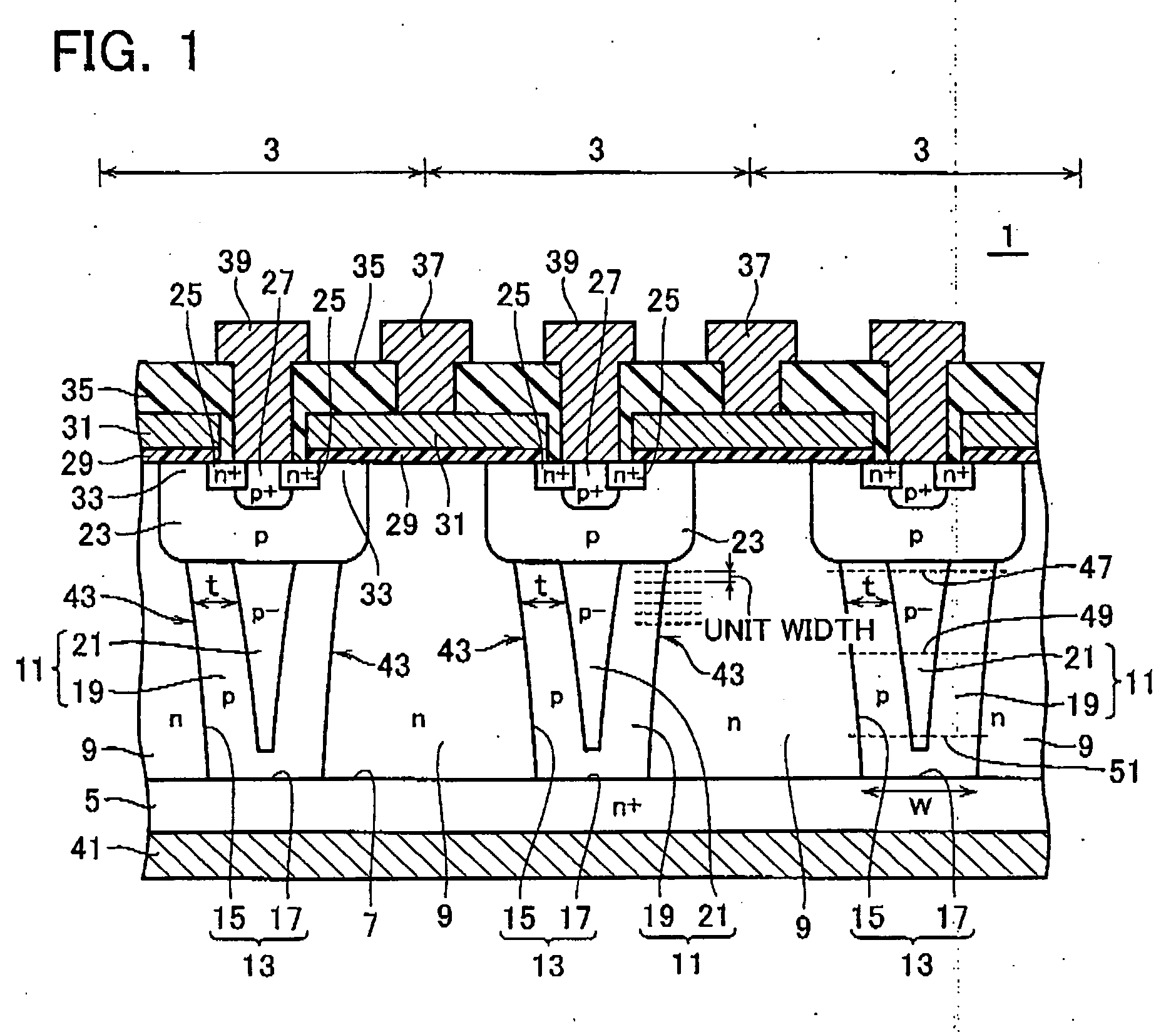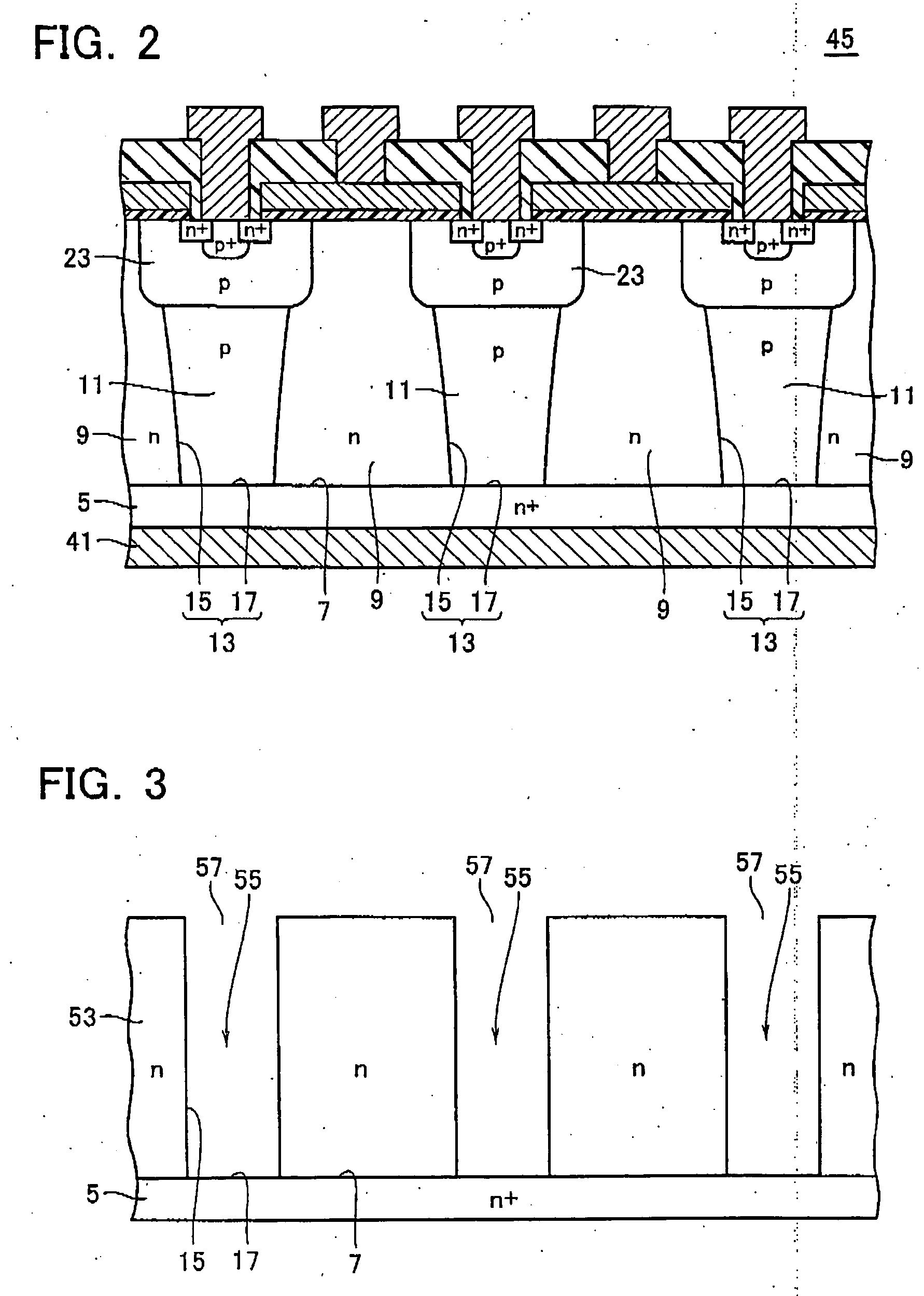Semiconductor device
- Summary
- Abstract
- Description
- Claims
- Application Information
AI Technical Summary
Benefits of technology
Problems solved by technology
Method used
Image
Examples
first embodiment
(Major Effect of First Embodiment)
[0055] The semiconductor device 1 shown in FIG. 1 according to the first embodiment is possible to improve the charge balance between the first and second semiconductor regions 9, 11 and enhance the breakdown voltage. This effect is described in comparison with a comparative example. FIG. 2 is a vertical cross-sectional view of part of a semiconductor device 45 according to the comparative example, which corresponds to FIG. 1. The semiconductor device 45 comprises p-type second semiconductor regions 11, which are not divided into the outer portion and the inner portion and have an overall impurity concentration of “p”. This is different from the first embodiment.
[0056] Hereinbelow, in order to clarify the effect of the embodiment, explanation are performed, wherein the first and second semiconductor regions 9 and 11 in FIG. 1 and FIG. 2 are divided by a unit width (i.e. 1 micrometer; see FIG. 1) respectively, in a direction from the surface 7 towar...
second embodiment
[0074]FIG. 10 is a vertical cross-sectional view of part of a semiconductor device 63 according a second embodiment. In the second embodiment, the first semiconductor region 9 is also composed of an outer portion 65 and an inner portion 67. The outer portion 65 and the inner portion 67 both are of n-type. The impurity concentration is higher in the outer portion 65 than in the inner portion 67 the outer portion 65 has an impurity concentration of “n” while the inner portion 67 has an impurity concentration of “n−”.
[0075] The outer portion 65 in the first semiconductor region 9 is formed opposite the outer portion 19 of the second semiconductor region 11 and against the side 15 of the trench 13. The outer portion 65 has an upper end brought into contact with the base region 23 and a lower end brought into contact with the semiconductor substrate 5. On formation of the outer portion 65, the thickness thereof is almost constant. The limitation, “on formation of the outer portion 65”, ...
third embodiment
[0082]FIG. 13 is a vertical cross-sectional view of part of a semiconductor device 71 according a third embodiment. The regions N1, N2, . . . Nm has impurity concentrations controlled to elevate as becoming more distant from the surface 7 of the semiconductor substrate. This is a difference between the third embodiment and the first embodiment shown in FIG. 1. FIG. 13 shows the elevation of the n-type impurity concentration as “n−−, n−, n”. The impurity concentration may be controlled to elevate in the form of steps or in the form of a smooth curve or straight line.
[0083] Both in the first and third embodiments, the inner portion 21 with the impurity concentration of “p−” has the width that extends as becoming more distant from the surface 7. Therefore, the number of impurity atoms in the inner portion 21 of the regions P1, P2, . . . Pm increases more or less as becoming more distant from the surface 7. The impurity concentration in the inner portion 21 is relatively small and negl...
PUM
 Login to View More
Login to View More Abstract
Description
Claims
Application Information
 Login to View More
Login to View More - R&D
- Intellectual Property
- Life Sciences
- Materials
- Tech Scout
- Unparalleled Data Quality
- Higher Quality Content
- 60% Fewer Hallucinations
Browse by: Latest US Patents, China's latest patents, Technical Efficacy Thesaurus, Application Domain, Technology Topic, Popular Technical Reports.
© 2025 PatSnap. All rights reserved.Legal|Privacy policy|Modern Slavery Act Transparency Statement|Sitemap|About US| Contact US: help@patsnap.com



